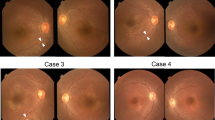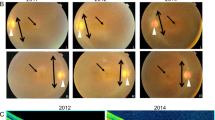Abstract
Autosomal recessive childhood-onset severe retinal dystrophy (arCSRD) designates a heterogeneous group of disorders affecting rod and cone photoreceptors simultaneously1. The most severe cases are termed Leber congenital amaurosis (LCA), while the less aggressive forms are usually considered juvenile retinitis pigmentosa. Recently, mutations in the retinal-specific guanylate cyclase gene were found in patients with LCA2. Disease genes implicated in other forms of arCSRD are expected to encode proteins present in the neuroretina or in the retinal pigment epithelium (RPE). The RPE, a monolayer of cells separating the vascular-rich choroid and the neuroretina, is in intimate contact with the outer segments of rods and cones via the microvilli surrounding the photoreceptors. The RPE expresses a tissue-specific and evolutionary highly conserved 61 kD protein (RPE65) present at high levels in vivo3–6. Although the function of RPE65 is not yet known, an important role in the RPE/photoreceptor vitamin-A cycle is suggested by the fact that RPE65 associates both with serum retinol-binding protein7,8 and with the RPE-specific 11-cis retinol dehydrogenase, an enzyme active in the synthesis of the visual pigment chromophore 11-cis retinal9. Here we report that the analysis of RPE65 in a collection of about 100 unselected retinal-dystrophy patients of different ethnic origin revealed five that are likely to be pathogenic mutations, including a missense mutation (Pro363Thr), two point mutations affecting splicing (912+1G→T and 65+5G→A) and two small re-arrangements (ins144T and 831del8) on a total of nine alleles of five patients with arCSRD. In contrast to other genes whose defects have been implicated in degenerative retinopathies, RPE65 is the first disease gene in this group of inherited disorders that is expressed exclusively in the RPE, and may play a role in vitamin-A metabolism of the retina.
This is a preview of subscription content, access via your institution
Access options
Subscribe to this journal
Receive 12 print issues and online access
$209.00 per year
only $17.42 per issue
Buy this article
- Purchase on Springer Link
- Instant access to full article PDF
Prices may be subject to local taxes which are calculated during checkout
Similar content being viewed by others
References
Heckenlively, J.R. & Foxmann, S.G. Congenital and early-onset forms of retinitis pigmentosa. in Retinitis Pigmentosa 107–149(ed. Heckenlively, J.R.) (Lippincott, Philadelphia, 1988).
Perrault, I. et al. Retinal-specific guanylate cyclase gene mutations in Leber's congenital amaurosis. Nature Genet. 14, 461–464 (1996).
Hamel, C.P. et al. A developmentally regulated microsomal protein specific for the pigment epithelium of vertebrate retina. J. Neurosd. Res. 34, 414–425 (1993).
Bavik, C.-O., Lévy, R., Hellman, U., Wernstedt, C., & Eriksson, U. The retinal pigment epithelial membrane receptor for plasma retinol-binding protein: isolation and cDNA cloning of the 63-kDa protein. J. Biol. Chem. 268, 20540–20546 (1993).
Hamel, C.P. et al. Molecular cloning and expression of RPE65, a novel retinal pigment epithelium-specific microsomal protein that is post-transcriptionally regulated in vitro. J. Biol. Chem. 268, 15751–15757 (1993).
Nicoletti, A. et al. Molecular characterization of the human gene encoding an abundant 61 kDa protein specific to the retinal pigment epithelium. Hum. Mol. Genet. 4, 641–649 (1995).
Bavik, C.-O., Eriksson, U., Alien, R.A. & Peterson, P.A. Identification and partial characterization of a retinal pigment epithelial membrane receptor for plasma retinol-binding protein. J. Biol. Chem. 266, 14978–14985 (1991).
Bavik, C.-O., Busch, C. & Eriksson, U. Characterization of a plasma retinol-binding protein membrane receptor expressed in the retinal pigment epithelium. J. Biol. Chem. 267, 23035–23042 (1992).
Simon, A., Hellman, U., Wenstedt, C. & Eriksson, U. The retinal pigment epithelial-specific 11-cis retinal dehydrogenase belongs to the family of short chain alcohol dehydrogenases. J. Biol. Chem. 270, 1107–1112 (1995).
Hamel, C.P., Jenkins, N.A., Gilbert, D.J., Copeland, N.G. & Redmond, T.M. The gene for the retinal pigment epithelium-specific protein RPE65 is localized to human 1p31 and mouse 3. Genomics 20, 509–512 (1994).
Nakai, K. & Sakamoto, H. Construction of a novel database containing aberrant splicing mutations of mammalian genes. Gene 141, 171–177 (1994).
van Soest, S. et al. Assignment of a gene for autosomal recessive retinitis pigmentosa (RP12) to chromosome 1q31–q32.1 in an inbred and genetically heterogeneous disease population. Genomics 22, 499–504 (1994).
Leutelt, J. et al. Autosomal recessive retinitis pigmentosa locus maps on chromosome 1q in a large consanguineous family from Pakistan. Clin. Genet. 47, 122–124 (1994).
Krawczak, M., Reiss, J. & Cooper, D.N. The mutational spectrum of single base-pair substitutions in mRNA splice junctions of human genes: causes and consequences. Hum. Genet. 90, 41–54 (1992).
Shapiro, M.B. & Senapathy, P. RNA splice junctions of different classes of eukaryotes: sequence statistics and functional implications in gene expression. Nucleic Acids Res. 15, 7155–7174 (1987).
Bunge, S., Fuchs, S. & Gal, A. Simple and nonisotopic methods to detect unknown gene mutations in nucleic acids. in Methods in Molecular Genetics, vol. 8 (ed. Adolph, K.W.) (Academic, Orlando, Florida, 26–39 1996).
Author information
Authors and Affiliations
Rights and permissions
About this article
Cite this article
Gu, Sm., Thompson, D., Srikumari, C. et al. Mutations in RPE65 cause autosomal recessive childhood–onset severe retinal dystrophy. Nat Genet 17, 194–197 (1997). https://doi.org/10.1038/ng1097-194
Issue Date:
DOI: https://doi.org/10.1038/ng1097-194
This article is cited by
-
Carrier frequency and incidence estimation of RPE65-associated inherited retinal diseases in East Asian population by population database-based analysis
Orphanet Journal of Rare Diseases (2022)
-
Extending the phenotypic spectrum of PRPF8, PRPH2, RP1 and RPGR, and the genotypic spectrum of early-onset severe retinal dystrophy
Orphanet Journal of Rare Diseases (2021)
-
The role of voltage-gated ion channels in visual function and disease in mammalian photoreceptors
Pflügers Archiv - European Journal of Physiology (2021)
-
Statement of the DOG, the RG, and the BVA on the therapeutic use of voretigene neparvovec (Luxturna™) in ophthalmology. English version
Der Ophthalmologe (2020)



